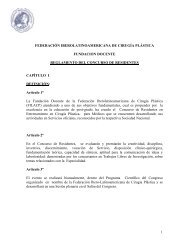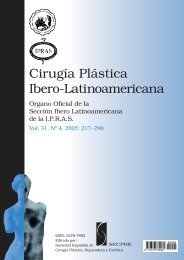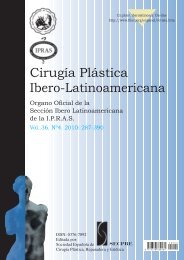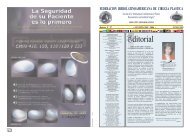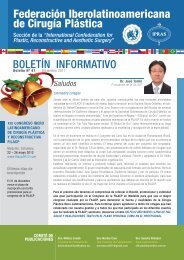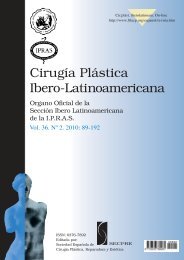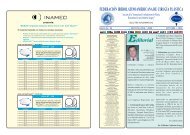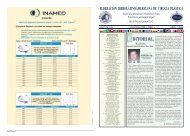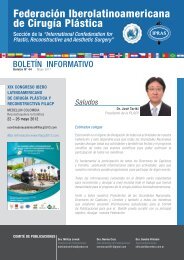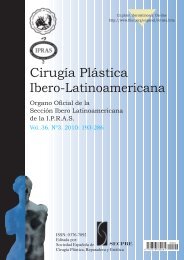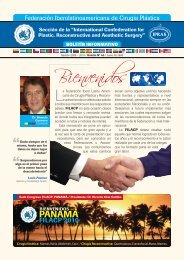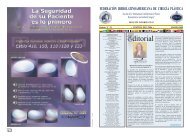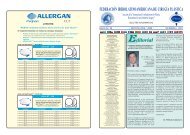Volumen 37 No. 4 - Planetec
Volumen 37 No. 4 - Planetec
Volumen 37 No. 4 - Planetec
Create successful ePaper yourself
Turn your PDF publications into a flip-book with our unique Google optimized e-Paper software.
CIRUGÍA PLÁSTICA IBERO-LATINOAMERICANA<br />
Cir.plást. iberolatinoam.-Vol. <strong>37</strong> - Nº 4<br />
Octubre -<strong>No</strong>viembre-Diciembre 2011 / Pag. 319- 324<br />
Obtención y criopreservación de células madre<br />
del tejido graso mediante liposucción<br />
Collecting and criopreservation of stem cells obtained by<br />
liposuction from fat tissue<br />
Planas Ribo, J.*, Coronel Gagliardi, R. **<br />
Planas Ribó, J.<br />
Resumen<br />
Existen diferentes técnicas para la obtención directa de células madre<br />
embrionarias a través de embriones criopreservados en nitrógeno líquido<br />
(-196 °C), blastómeros individuales, activación de ovocitos por transferencia<br />
nuclear y células madre del líquido amniótico. También es posible obtener células<br />
madre adultas hematopoyéticas y de la médula ósea, más conocidas y<br />
empleadas en la clínica desde hace tiempo, así como también de la sangre del<br />
cordón umbilical en recién nacidos y de la grasa corporal en adultos.<br />
La grasa autóloga corporal extraída mediante liposucción se reutiliza en<br />
ocasiones para injertar o infiltrar otras zonas corporales y faciales como material<br />
de relleno, pero en la mayoría de los casos es desechada. Por lo general,<br />
para obtener un resultado satisfactorio en el trasplante de grasa autóloga,<br />
son necesarios varios tiempos quirúrgicos por lo que sería muy útil contar con<br />
un banco de tejido adiposo personalizado. Existen diferentes estudios que demuestran<br />
que el tejido adiposo aspirado por liposucción convencional puede<br />
preservarse y almacenarse con éxito a baja temperatura (-85 °C) en banco de<br />
tejido para futuras aplicaciones.<br />
Las células madre mesenquimales (MSCs) poseen gran capacidad de proliferación<br />
y diferenciación con un alto valor terapéutico. El tejido graso es un<br />
reservorio importante de MSCs capaces de diferenciarse en tejido óseo, cartilaginoso,<br />
muscular, etc. Si reservamos una pequeña cantidad del tejido graso<br />
lipoaspirado, podemos obtener una cantidad suficiente de MSCs y conservarlas<br />
mediante un método óptimo de criopreservación.<br />
En 2007 realizamos un estudio de la grasa lipoaspirada en 36 pacientes<br />
para demostrar y validar el método de obtención de tejido graso con su posterior<br />
traslado, manipulación y criopreservación en banco de células madre.<br />
Los resultados fueron satisfactorios y en junio del 2010 se validó el método<br />
de recogida, procesamiento y almacenamiento de una mezcla enriquecida de<br />
células madre adultas de tejido graso aspirado. Dicho método permite a todas<br />
aquellas personas que no hayan tenido la oportunidad de almacenar su cordón<br />
umbilical al nacer, almacenar MSCs obtenidas de la grasa de liposucción.<br />
La criopreservación conservará las células durante años que, en el momento<br />
de ser requeridas por el paciente, se descongelarán, pudiéndose recuperar<br />
alrededor del 80% de las mismas.<br />
Abstract<br />
There are different techniques to obtain embryonic stem cells directly<br />
through cryopreserved embryos in liquid nitrogen (-196ºC), individual blastomers,<br />
ovocyte activation by nuclear transfer and stem cells from amniotic<br />
fluid, among others. It is also possible to obtain hematopoietic adult stem cells<br />
and those from the bone marrow, better well-known and used in clinics for a<br />
long time; besides, from the blood of umbilical cord in newborns and body fat<br />
in adults.<br />
The autologous fat extracted from the body using liposuction, is sometimes<br />
reused to inject or infiltrate other body and facial areas as a filling material,<br />
but in most of the cases, it is thrown away. Sometimes it´s necessary to<br />
perform several surgical operations; therefore, it would be very useful to count<br />
on a bank of personalized adipose tissue. There are different studies that demonstrate<br />
that adipose tissue obtained through conventional liposuction can<br />
be preserved and stored successfully at a low temperature (-85 ºC) in a tissue<br />
bank for a future use.<br />
Mesenchymal stem cells (MSCs) are those with a high capacity of proliferation<br />
and differentiation with a high therapeutic value. Fat tissue is an important<br />
reservoir of MSCs, able to be differentiated in osseous, cartilaginous,<br />
muscular, etc. tissues. Therefore, if we reserve a small amount of fat tissue obtained<br />
through liposuction, we can get the enough amount and preserve the<br />
MSCs with the best method of cryopreservation.<br />
In 2007 we carried out a study of the fat obtained though liposuction in<br />
36 patients, in order to demonstrate and validate a method for adipose tissue<br />
acquisition, with the subsequent transfer, manipulation and cryopreservation<br />
in a stem cells bank. The results were satisfactory, and in June 2010 the method<br />
for collecting, processing and storing an enriched adult stem cells mixture<br />
of sucked fat tissue was validated. This method gives the opportunity to<br />
anybody, who did not have the chance to store the umbilical cord when was<br />
just born, to keep stem cells from liposuction fat.<br />
Cryopreservation will preserve stem cells during years and, when the patient<br />
requires them, they will be thawed, and about an 80 % of them recovered.<br />
Palabras clave<br />
Células madre, Liposucción,<br />
Criopreservación.<br />
Key words<br />
Stem cells, Liposuction,<br />
Cryopreservation.<br />
Código numérico 19-266<br />
Numeral Code 19-266<br />
* Cirujano Plástico y Director Médico.<br />
** Cirujano Plástico<br />
Clínica Planas. Barcelona, España.



